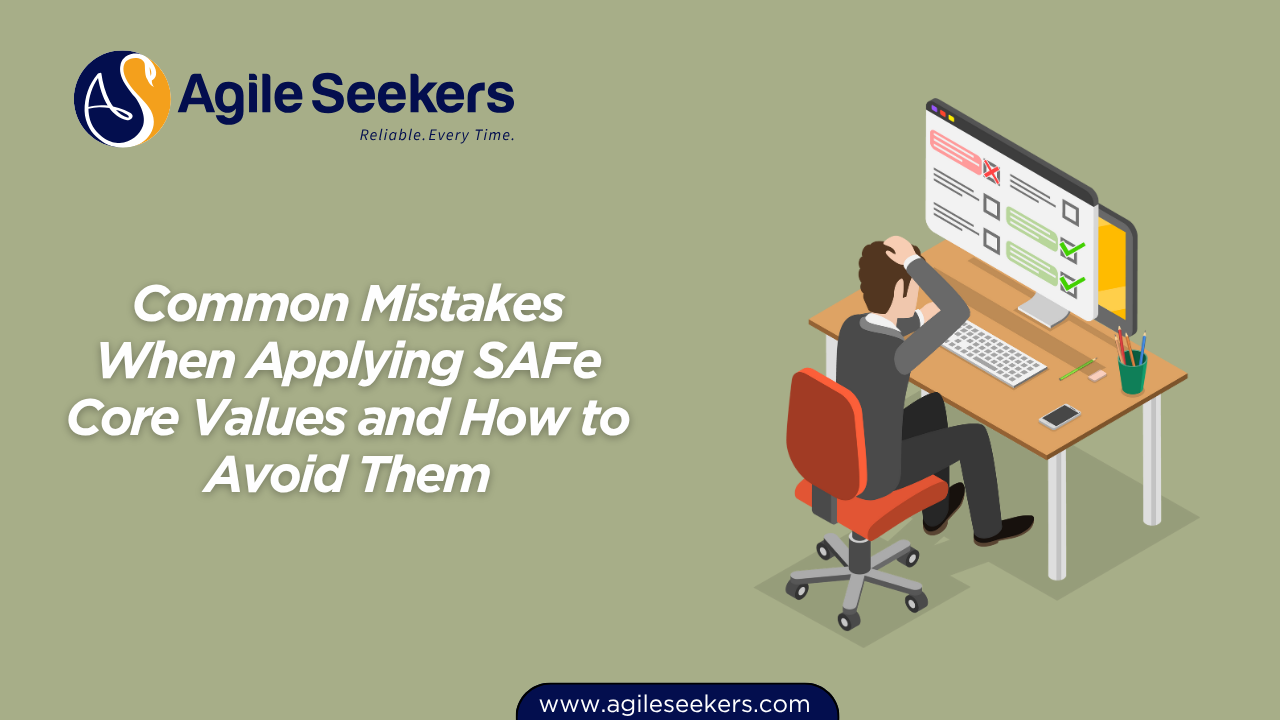Common Mistakes When Applying SAFe Core Values and How to Avoid Them

If you’re rolling out SAFe, you’ll keep hearing about the four Core Values: Alignment, Built-in Quality, Transparency, and Program Execution. On paper, it sounds simple. In real life, most organizations slip up—not because they ignore these values, but because they misunderstand or half-apply them.
Let’s break down the classic mistakes, and what you can do differently.
1. Treating Core Values as Checkboxes, Not Behaviors
The mistake:
Plastering SAFe Core Values on posters, reciting them in meetings, and then getting back to business as usual. If alignment, transparency, built-in quality, and program execution aren’t part of how people make decisions daily, it’s just empty branding.
How to avoid it:
-
Build habits, not slogans. For example, don’t just say you value transparency—invite teams to review portfolio Kanban boards and discuss blockers openly.
-
Leaders should model behavior. If the leadership team hides tough news or “manages” information flow, everyone else will do the same.
-
Bake Core Values into how you run events: retrospectives, PI Planning, even daily standups.
Want to see this in action? Leading SAFe Agilist Certification Training actually dives deep into how these values show up in real decisions.
2. Focusing on Processes, Ignoring People
The mistake:
Believing SAFe is only about frameworks, boards, and artifacts. But it’s people—how they interact, share feedback, and solve problems together—that make the values real.
How to avoid it:
-
Put respect for people and culture at the center.
-
Set up regular feedback loops—skip-level 1:1s, peer recognition, and open Q&As with leadership.
-
Encourage psychological safety. Teams need to feel safe to admit mistakes and surface issues.
Pro tip: Consider SAFe Product Owner/Product Manager (POPM) Certification to really understand the people side of value flow.
3. Alignment Becomes Command-and-Control
The mistake:
Interpreting “alignment” as top-down control, where leaders dictate and teams just follow orders. Real alignment in SAFe is about shared vision and goals, not marching orders.
How to avoid it:
-
Align on outcomes, not instructions. Set clear intent, but let teams figure out how to get there.
-
Use Objectives and Key Results (OKRs) or similar goal-setting frameworks that focus on results, not tasks.
-
Empower ARTs and teams to make local decisions.
If you’re leading a team, check out SAFe Scrum Master Certification to learn how to foster alignment without micromanagement.
4. Transparency in Name, Opaqueness in Practice
The mistake:
Declaring everything “transparent” but actually keeping decision-making, metrics, or roadmaps in silos. Teams know when information is filtered or sugarcoated.
How to avoid it:
-
Make portfolio Kanban boards, OKRs, and key metrics visible to everyone.
-
Hold open forums for questions and real talk—not just polished status updates.
-
When you can’t share something, be honest about why.
Transparency is more than dashboards; it’s about trust. SAFe Advanced Scrum Master Certification Training explores techniques to foster real openness across teams.
5. Quality Left Until the End
The mistake:
Assuming “built-in quality” just means a round of testing at the end of the sprint or PI. Real quality is engineered in, not inspected in.
How to avoid it:
-
Build quality into every step: Definition of Done, TDD, automation, pair programming, peer reviews.
-
Treat technical debt as a blocker, not just a backlog item.
-
Involve the whole team in quality conversations, not just testers.
A deeper dive into flow and quality can be found in SAFe Release Train Engineer Certification Training.
6. Execution Without Learning or Improvement
The mistake:
Measuring “program execution” purely by throughput or how much you shipped. It’s easy to deliver features but hard to deliver value if you’re not learning or improving.
How to avoid it:
-
Build relentless improvement into your cadence. Make Inspect & Adapt workshops non-negotiable.
-
Celebrate experiments and learning, not just big deliveries.
-
Track value delivered, not just features completed.
Want practical tips? SAFe Scrum Master Certification has a section on driving continuous improvement in the real world.
7. Misunderstanding the Role of Leadership
The mistake:
Assuming the Core Values are “for the teams” while leadership remains hands-off or transactional.
How to avoid it:
-
Leaders need to lead by example: join events, share mistakes, and show vulnerability.
-
Practice servant leadership. Remove obstacles instead of creating new rules.
-
Invest in leadership development—agile isn’t just for the teams, it’s for the whole company.
Here’s a good resource on the importance of leadership in SAFe.
8. Failing to Adapt Core Values to Context
The mistake:
Copy-pasting the “official” values into your organization without translating them to your context, language, and culture.
How to avoid it:
-
Run workshops where teams describe what each Core Value looks like for them.
-
Use real scenarios from your environment, not generic SAFe examples.
-
Update your working agreements as you learn and evolve.
For teams managing complex environments, the SAFe Release Train Engineer Certification Training covers how to make SAFe fit your organization.
Wrapping Up: Core Values Are Lived, Not Stated
SAFe Core Values aren’t a formality or a slide deck—they’re practical, sometimes uncomfortable, and always about how people show up day-to-day.
To get it right:
-
Focus on habits and behaviors, not just words.
-
Balance process with people.
-
Make alignment about shared intent, not control.
-
Push for genuine transparency.
-
Build quality in, don’t tack it on.
-
Learn and adapt, don’t just execute.
-
Lead by example—always.
-
Tailor values to your context.
If you’re serious about embedding these values for real, the next step is learning, experimenting, and coaching at every level.
And if you want to go deeper or need structured help, certifications like Leading SAFe Agilist, POPM, Scrum Master, Advanced Scrum Master, and Release Train Engineer can be a solid investment.
Also read - How to Encourage Relentless Improvement with Lean Agile Mindset
Also see - Building Trust and Transparency with SAFe Core Values




















